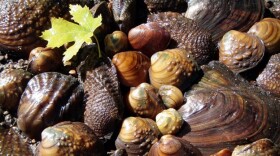Like many of my Northwoods neighbors, I flew south this winter. I am in Florida, but my stay involves an intensive two-week marine field research course with two co-instructors and 15 UW-Madison students. For many of the crew, this is a first time seeing below the ocean’s waters and the impact and amount of learning is immense. In the first few days we have stuck close to the shoreline while everyone gets confident snorkeling. Nearshore areas like seagrass beds, sand flats, and mangrove roots are often overlooked habitats by folks who prioritize visits to the showier, more colorful coral reefs. Yet, the plethora of plants and animals in these environments have happily enthralled us for days!
Even before entering the water, we encountered burrowing and tide pool dwelling critters. Small fiddler crabs moved in and among the mangrove roots racing near the waters edge and back up, burrowing into small openings when we got too close. These feisty crabs have one small claw and one overly large claw that they will wave in your direction if you get to close. The number of tiny holes along the shore and just below the waters edge could yield a days digging adventure quantifying the crabs, worms, and unknown inhabitants of holes at different water depths.
The adjacent rocky shoreline is one typical of Florida. Limestone, deposited over millions of years by corals and other calcium carbonate fixing marine animals, is the primary material that composes the sediments of southern Florida. As water erodes the limestone it becomes porous and develops sinkholes, underwater rivers, and spectacular cave systems. At the shoreline, these eroded holey rocks hold pools of sea water where small creatures abound. In these pools, students found fuzzy chitons, small limpet-like creatures tightly attached to the rocks, barnacles, sponges, tunicates, and even a large green moray eel hiding in a crevice. In just one pool, we can find representatives of many different major groups of plants and animals co-existing in close quarters.
From the rocky shoreline, we geared up into wet suits headed out from a beach area in the shallows. Surrounded by castle-building kiddos and sun-collecting vacationers, our group of studious snorkelers provided a contrasting image as they prepared to interact with the ocean coast in a very different way. The sandy swimming area is full of burrows and mounds of sand created by large floppy burrowing lugworms. We also encounter rolling balls or long strings of algae that commonly wrap around swimmers’ legs. When viewed underwater, these are composed of multiple multicellular algal species interspersed with tiny marine animals like sponges, tunicates, shrimp, crabs and more.
Our destination is the shallow sea grass beds and mangrove tree roots that extend 3-4 feet down into the water. Turtle, manatee, and shoal grasses make up seagrass beds throughout the Florida Keys and are flowing plants that derive from terrestrial grass ancestors. They have evolved special oxygen transport and osmotic adaptations to survive in salty underwater habitats. Sea grass beds stretch for miles near shore and are some of the most productive marine habitats, analogous to highly productive grassland and agricultural regions on land. And, just like on land herbivores take advantage of these abundant resources, but in the ocean the major seagrass grazers are turtles and manatees. Sea stars, sponges, urchins, snails, and crabs found in the seagrass are often less showy than their reef cousins but abundant and fun to find in their camouflaged refuges.
Across from the sea grass flats, we broached the mangrove forest with bushy trees pointing upward and thin prop roots extending downward into the water. Mangrove roots provide cover for many species of juvenile reef fish. Colorful, tiny, spotted, striped, reds, purples, yellows, and blues, 1-2 inch fish flit in and out of cover. They feed on plankton and small invertebrates that grow in and among the mangrove roots which host an entire ecosystem of interacting creatures.
Tomorrow, it is off to the reef where things move a bit faster and are showier. But, I am grateful for the time we spent in the shallows and hope that we will all carry forward an appreciation of what can be found close to shore when we look under the surface and let nature be our guide.









